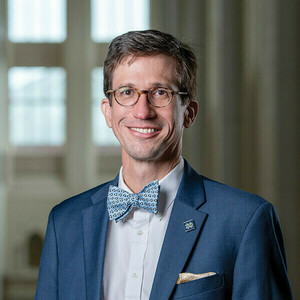Collaboration leads to discovery of how ovarian egg cells may develop
When Lei Lei was an assistant professor at the University of Michigan studying the way germ cells—the precursors to human reproductive cells—form physical “bridges” that help determine their fate, she realized there were no wet-lab experiments that could yield convincing results.

So she turned to a senior member of the faculty, Santiago Schnell. Schnell, who is now William K. Warren Foundation Dean of the College of Science at the University of Notre Dame, is a computational biologist who at that time chaired the Department of Molecular & Integrative Physiology at the University of Michigan Medical School. Together, the research teams discovered a new molecular mechanism for how cells in ovaries, called oocytes, are made available for sustaining ovarian function during the development of fetal ovaries.
Their paper was published recently in Proceedings of the National Academy of Sciences.
“We wanted to see if the outcome on a larger scale matched the snapshot we saw in the lab,” said Lei, now an associate professor of obstetrics and gynecology at the University of Missouri School of Medicine, describing how the mathematical-based computer code contributed to the research: Schnell used his computational skills to help her determine that cell death inside fetal ovaries does not take place randomly.
“This is something we couldn’t do just by doing experiments,” Lei said.
In mammals, there is a large-scale “death” of germ cells in the ovaries of fetuses. This results in only a small proportion of those cells becoming oocytes. Lei’s lab discovered that the germ cells form branched cyst structures, where about 20 percent of the germ cells are connected by three or four physical bridges. In female cysts, the individual germ cells share cellular materials from their sister germ cells. The more connections they make, the better their chance of becoming an oocyte.
“Female cells are all about ‘nursing’ to make a few good oocytes,” Lei said, adding that with male cells, “if one saw something was wrong, the whole cyst structure would collapse.”
Schnell’s model was key to cementing the results Lei had seen. “His lab laid out a really nice computer program, and as we worked on this we found this is a beautiful, and not random process, with how cells decide their fate,” she said.
Other collaborators include first author Kanako Ikami, who was Lei’s postdoctoral researcher and is now at the University of California, Davis; Suzanne Shoffner-Beck, at University of Michigan; Malgorzata Tyczynska Weh, now at the University of South Florida; Shoshei Yoshida, of the School of Life Science in Kanagawa, Japan; and Edgar Andres Diaz Miranda and Sooah Ko, both of the University of Missouri School of Medicine.
Lei appreciates working collaboratively and noted that all areas of the research for this paper took different skill sets, but in working together they can achieve a broader goal.
“Today, science addresses incredibly complex questions conducting research collaboratively,” Schnell said. “Team science is leading to scientific discoveries that wouldn’t have been possible otherwise, resulting in greater scientific impact, innovation and productivity than the single investigator approaches.”
Originally published by at science.nd.edu on June 05, 2023.
Latest Research
- Brain tumor growth patterns may help inform patient care managementAssistant Professor Meenal Datta (University of Notre Dame/Wes Evard) A team of researchers from the University of Notre Dame, Harvard Medical School/Massachusetts General Hospital, and Boston University has developed a technique for measuring a brain tumor’s mechanical force and a new model to estimate how much brain tissue a patient has lost.
- Biseach Symposium Strengthens Cancer Research Partnership Between Notre Dame and University of Galway…
- Notre Dame announces new research collaborations with Ukrainian Catholic UniversitySeven faculty teams of collaborators from the University of Notre Dame (South Bend, Indiana, USA) and Ukrainian Catholic University (Lviv, Ukraine) have received grants from Notre Dame Global and Notre Dame Research to pursue…
- From reaction to resolution: The future of allergy treatmentTwelve-year-old Lauren Eglite was thrilled to attend a Notre Dame football game with her father, Erik, in 2017, even though her acute peanut allergy demands constant vigilance. She was even more excited when the stadium’s brand-new video board aired an NBC Fighting…
- New Study Highlights Mother-Child Link for Anemia in The GambiaAnemia is a "silent epidemic." It affects nearly 2 billion people globally, yet many people ignore its symptoms. Typically caused by the consumption of iron-deficient foods, anemia develops gradually. Its symptoms—such as fatigue, weakness, and shortness of breath—are frequently dismissed or misattributed.
- Megan McDermott joins ND–IBM Tech Ethics Lab as new Notre Dame directorThe Notre Dame–IBM Technology Ethics Lab, a critical component of the Institute for Ethics and the Common Good (ECG) and the Notre…












